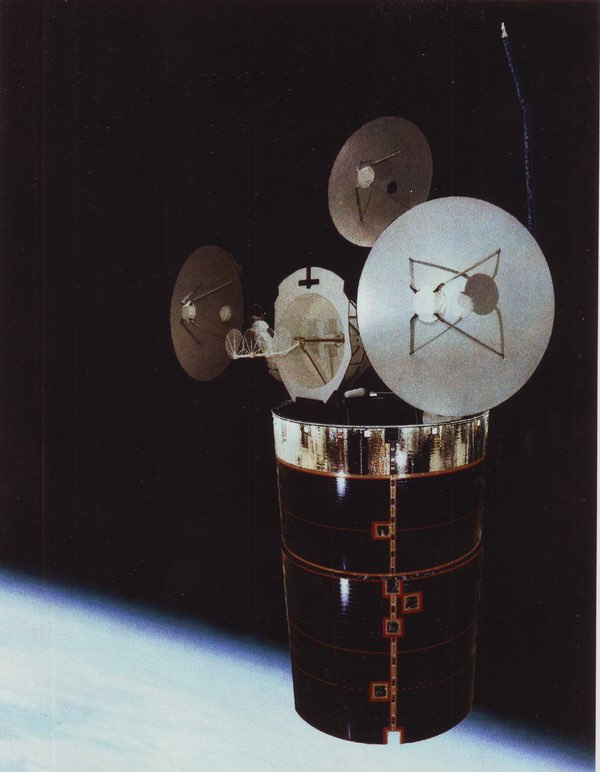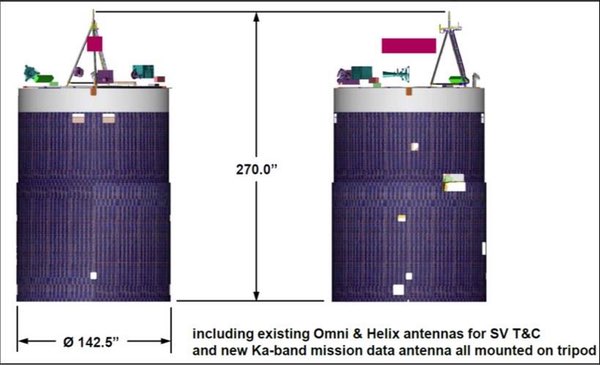
Spinning out of the shadowsby Dwayne Day
|
| There is strong evidence to indicate that it is the exact same spacecraft shown in the final stages of construction in 1998, a satellite known as QUASAR. |
On February 15, NASA issued a request for information on the use of a “NASA Science/Technology Platform Satellite,” or NSTP-Sat. NSTP-Sat will use “a spacecraft platform that has become available to NASA as excess Government property through an interagency agreement,” according to the document. The NSTP-Sat could be launched on a NASA-purchased rocket or co-manifested with the second SLS launch, presumably being carried underneath an Orion spacecraft and its service module.
The information released on the excess government spacecraft indicates that it is one of the same types of satellites as first revealed back in 1998. In fact, there is strong evidence to indicate that it is the exact same spacecraft shown in the final stages of construction in 1998, a satellite known as QUASAR.
QUASAR was the code name for a series of data-relay satellites developed starting in the early 1970s under the unclassified name Satellite Data System (SDS). There were apparently six or seven first-generation SDS satellites launched starting in the mid-1970s and used to relay imagery from low-flying KENNEN imagery satellites. The KENNENs operated in polar orbit and the SDS satellites operated in highly-elliptical, highly-inclined orbits known as “Molniya,” after the Soviet communications satellites that first occupied them. This unique orbit meant that an SDS satellite would move high and slow over the northern hemisphere, which placed it in line of site between a KENNEN satellite flying over the Soviet Union below and a ground station outside of Washington, DC. The first block of SDS satellites were based upon the proven Hughes Intelsat IV communications satellite design, which looked like a barrel topped with antennas.
Starting in 1989, the National Reconnaissance Office launched the first of a second block of SDS satellites, based upon the Hughes 389 communications satellite model, more commonly known as Intelsat VI. A total of five Intelsat VI satellites were launched between 1989 and 1991. The powerful but relatively obscure satellite earned fame in 1992 when the space shuttle Endeavour rendezvoused with Intelsat 603, which had become stranded in low Earth orbit after its launch two years earlier. Astronauts attached a new rocket motor to the satellite and it was boosted into geostationary orbit in May 1992, where it operated until January 2013.
A total of five of the SDS block 2/QUASAR satellites were launched between 1989 and January 1998—before the NRO showed off one in a clean room. The second satellite operated in geosynchronous orbit for just over 24 years. The Intelsat VI, and the SDS block two satellites, were both spin-stabilized. Their main bodies were short, squat cylinders with an “antenna farm” on top. They were also equipped with a “drop skirt,” a cylindrical tube covered with solar cells that was retracted over the main body during launch and then deployed after achieving orbit, increasing the amount of available solar paneling.
| With eight launches since the cylindrical spacecraft was revealed in 1998, and none of them matching its characteristics in orbit, it seems highly likely that the surplus satellite is the one revealed nearly two decades ago. |
After the QUASAR satellite was publicly revealed in 1998, satellite observers waited for signs of it being launched. They did this knowing the orbits that classified satellites were being launched to, and then observing the satellites in orbit, comparing them to previous similar satellites in order to better guess their identity. But the next time a suspected QUASAR satellite launched, in December 2000 on an Atlas IIAS rocket, independent satellite observers noticed that the satellite had different characteristics than the one launched in early 1998 and earlier satellites. This and subsequent launches—seven in all between December 2000 and May 2014—seemed to be a new class of three-axis stabilized spacecraft. In July 2016, yet another new spacecraft launched, apparently the fourth block of Satellite Data System satellites launched over a period of four decades. With eight launches since the cylindrical spacecraft was revealed in 1998, and none of them matching its characteristics in orbit, it seems highly likely that the surplus satellite is the one revealed nearly two decades ago.
 An illustration of a QUASAR satellite in orbit. |
The National Reconnaissance Office launched the first of these QUASAR satellites in August 1989, aboard the space shuttle Columbia during mission STS-28. The second launched in November 1990, aboard Atlantis during STS-38. The third launched in December 1992, aboard Discovery during STS-52. Both the STS-28 and STS-52 missions launched to high-inclination orbits. The STS-38 mission was unusual, because it flew to a lower-inclination and launched its QUASAR satellite to geosynchronous orbit. Although launching an SDS satellite to geosynchronous orbit was unique at the time, a court case later provided public evidence that it was the second of the second-generation satellites when court documents referred to the satellite as “B-2.”
After STS-52, the remaining QUASARs were launched on expendable rockets. A Titan IVA launched in July 1996 carried the fourth QUASAR to a Molniya orbit, and an Atlas IIA launched in January 1998 carried the last one, also to a Molniya orbit.
| SDS | USA Number | Designation | Launch | Orbit | Launch Vehicle |
|---|---|---|---|---|---|
| 2-1 | 040 | 1989-061B | Aug 1989 | MOL | STS-28 |
| 2-2 | 067 | 1990-097B | Nov 1990 | GEO | STS-38 |
| 2-3 | 089 | 1992-086B | Dec 1992 | MOL | STS-53 |
| 2-4 | 125 | 1996-038A | Jul 1996 | MOL | Titan IVA |
| 2-5 | 137 | 1998-005A | Jan 1998 | MOL | Atlas IIA |
Because it was derived from the Intelsat VI satellite bus, QUASAR presumably had many of the same capabilities. But it was not until NASA released its request for information that any specific details became available. NASA provided the following data on the satellite:
| Payload Mass: | 575 kg |
| Power: | 1200 W (30V bus) |
| Thermal Dissipation (Payload): | 600 W |
| Payload Mounting Area: | 209 ft^2 (shelf and panels) |
| Design Life: | 8 years (GEO) |
| Propellant System: | Bipropellant |
| Dimensions Height:: | 270.0 in; diameter 142.5 in (w/omni) |
| Payload Fairing: | 4-meter fairing |
| T&C: | S-band |
| Spin Rate: | Variable |
| Launch Vehicle: | EELV-M, Falcon 9, SLS |
| Baseline Jitter: | 3 arc-sec elevation; 20 arc-sec azimuth (plane of rotation) |
 A figure from the NASA RFI that that provided technical details about the spacecraft. |
According to NASA, the specific objective of the request for information is to seek information that will assist NASA’s Science Mission Directorate in the potential planning for a NASA Science/Technology Platform Satellite Mission. The mission could conduct either scientific observations or technology development, although the satellite is not capable of interplanetary missions.
NASA’s notional timeline starts at payload selection and authority to proceed. Forty-four months later the payload would be shipped to the launch site and launched at the 50-month mark or later. Assuming that it may take NASA a year to make a decision on payloads, that means launch would occur in 2022 or later, at least 24 years after the spacecraft was originally built. If the spacecraft does not fly, perhaps it—along with its antenna farm—will end up in the National Museum of the United States Air Force in Dayton, Ohio, hanging near the HEXAGON and GAMBIT reconnaissance satellites and the leftover Titan IV rocket that could have, in an alternate universe, once lofted it into orbit.